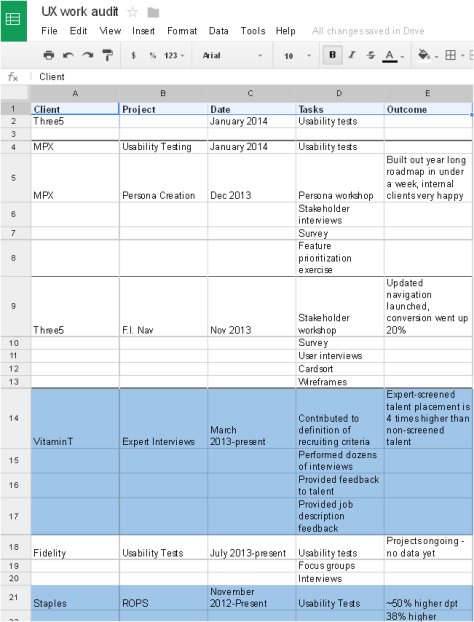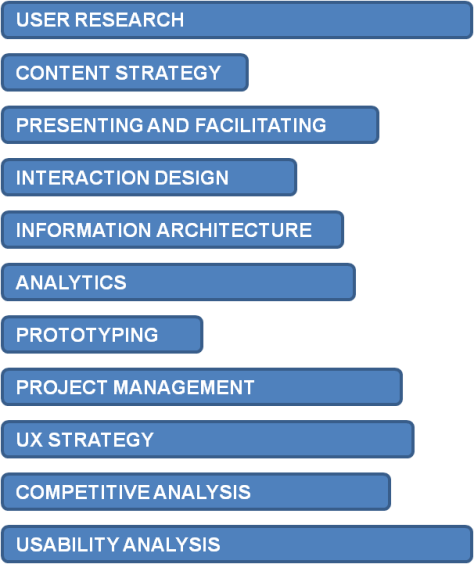Based on the resumes and portfolios that I’ve reviewed, it’s clear that many UX professionals get lost when it comes to presenting themselves and their work. They struggle with deciding what deliverables to show or how to describe their particular role on a project.
But, luckily, UX professionals already have a set of skills to draw on that should enable them to present themselves effectively when applying for new job opportunities. The tenets of user-centered design guide our project work every day, and each of us probably leverages specific best practices to make our project work as effective and efficient as possible. So, let’s take a look at some of the UX best practices that we can apply in creating successful resumes and portfolios. The same UX best practices that entice new users can entice potential employers as well:
- user research—Take users’ context of use into consideration when defining personas to represent them.
- content strategy—Make a comprehensive list of all existing content and weed out the ROT—content that is redundant, outdated, or trivial.
- UI design—Visually highlight one core component or piece of information.
- usability testing—Follow the 5-user golden rule to maximize your usability-testing efforts.
As a UX professional, whether you are actively searching for a full-time, in-house role; looking for freelance work; or responding to a request for proposal for consulting work, you need to apply these UX best practices to your resume, portfolio, and communications.
User Research: Getting to Know Users and Their Context
Everyone in the UX industry can probably agree that the key to designing a great user experience is gaining a thorough understanding of the people for whom we’re designing it. While there have been some debates about the best way to describe users and personas have been taking a bit of a hit lately,![]() I’m in the camp that believes personas can be very useful when one does them right. My rule for doing personas right is to make sure that I identify and consider the context surrounding how people will use what I create.
I’m in the camp that believes personas can be very useful when one does them right. My rule for doing personas right is to make sure that I identify and consider the context surrounding how people will use what I create.
Taking a step back, a persona’s purpose is to aid us in understanding users, so we can make good product design decisions. While information such as a persona’s favorite color or breakfast routine can add personality, it’s more important to understand how, where, and when your users will interact with a product.
Consider this example from an email platform that I once worked on: One of our personas comprised the owners of bricks-and-mortar businesses such as flower shops and bakeries, who usually wrote email messages at their shop. We found that this meant they were extremely likely to be interrupted by a customer, phone call, or employee question in the middle of writing a message. They would often lose their work when they left the page to attend to whatever other task called their attention away, which was hugely frustrating. We were able to prioritize creating new tools to address that issue, and customer satisfaction went up immensely. That seemingly insignificant context detail turned into a guiding principle for a complete redesign and was a major driver of success.
Designing your resume and portfolio is no different. In this case, the primary user is the prospective employer—whether that is a recruiter, a hiring manager, or a client soliciting your services. Understanding the context in which they’ll be viewing you and your online deliverables can help you to set your expectations appropriately and deliver the key information that they need in the best way.
Here are a few of my observations about prospective employers: First, people seeking UX professionals are almost universally pressed for time; often under pressure to find the right fit as soon as possible. Second, most talent-seekers are not intimately familiar with the nuances of UX roles. Individual clients are notorious for misunderstanding user experience,![]() and when we’re applying directly to a company, it is often an HR staffer or a specialized recruiter who first sees our work, neither of whom usually have a background in user experience. As UX professionals, many of us can attest to the frustration of companies recruiting us for roles that don’t suit us, and recruiters experience frustrations finding UX talent
and when we’re applying directly to a company, it is often an HR staffer or a specialized recruiter who first sees our work, neither of whom usually have a background in user experience. As UX professionals, many of us can attest to the frustration of companies recruiting us for roles that don’t suit us, and recruiters experience frustrations finding UX talent![]() as well.
as well.
We can use the power of the Internet to better understand particular interviewers. Although most of us probably won’t be able to survey interviewers or watch them interview someone else, we can unleash our inner detective. When applying to a specific company, go to their site and to job-review sites to find out about their culture, products, and projects. Identify your interviewer and learn more about his or her background, needs, and interests on LinkedIn, Twitter, or a personal blog. Since it’s rare for you to have only one target user, take the opportunity to learn as much as you can about all of them, and use that knowledge to your advantage. Mentioning a shared interest or a personal fact helps you to connect with interviewers, demonstrates your ability to perform research, shows your attention to detail, and lets you demonstrate empathy.
Content Strategy: Analyzing the Content
Once you’be carefully considered your audience and created a context-rich persona, it’s time to start creating or updating your deliverables: your resumes and portfolios. Many Web content projects begin with a content audit to document all of the content on a site. When working on your resumes, portfolios, and Web site, an audit lets you take an inventory of your deliverables, documents, and notes, Starting with a comprehensive list of everything you want to include in those documents makes it easier to analyze our work, identify the most important pieces, and spot and remove the ROT—redundant, outdated, or trivial content.
When you’re pulling together content you’be already created, deciding what pieces of work to show can be tricky, especially for those of us who specialize in research or strategy. I frequently get questions about what a portfolio should include, whether the format matters, and how interactive it should be. There is no one right answer, but every UX professional should have some kind of visual representation of their work. This visual representation could be as simple as a graph of survey results or annotated screenshots of the final product. Even user researchers who have never created a comp can use visuals to represent their work. Show persona documentation, photos of a focus group or participatory design session, or snapshots of research plans or reports. Images are easier to digest and help recruiters to quickly understand what types of work you do and don’t do.
UX professionals must also highlight their personal success metrics to clarify their value to non-UX-minded recruiters. Perhaps you streamlined the design process and were able to get a product to market much faster than expected or customer retention soared after your Web-site redesign launched. Clearly defining your challenges and how you were able to make things better lets you speak a language that everyone can understand, without needing any in-depth technical or UX knowledge.
The easiest way I’ve found to document and analyze my work is to keep an ongoing log of my projects with high-level descriptions of my tasks and their outcomes, using the same structure as a typical content audit. I make the listing as comprehensive as possible and note whether I’ve already included something in my portfolio. When it’s time to update my resume or portfolio, I quickly scan the document to see what new items I might want to highlight and can quickly see whether something overlaps too much with a previous project. While this log can sometimes be a pain to keep up, it helps me to display my best work. Figure 1 shows the content audit I prepared when creating my resume and portfolio.


